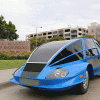From Concept to Car
 Nov. 30, 2017 - Samueli School graduate student Joseph Bell had big plans when he began thinking about the project required for his master’s degree in mechanical engineering. His idea was to design and simulate a hybrid electric/hydrogen fuel cell vehicle. Bell accomplished that goal and then some; he actually constructed a fully operational vehicle with encouragement from his adviser, Samueli School Dean Gregory Washington.
Nov. 30, 2017 - Samueli School graduate student Joseph Bell had big plans when he began thinking about the project required for his master’s degree in mechanical engineering. His idea was to design and simulate a hybrid electric/hydrogen fuel cell vehicle. Bell accomplished that goal and then some; he actually constructed a fully operational vehicle with encouragement from his adviser, Samueli School Dean Gregory Washington.
“I am your stereotypical definition of a ‘car guy,’” Bell says, “and Dean Washington wanted me to have a project that I’d enjoy while at the same time working on something futuristic in the automotive field.”
Construction began in spring 2016, using the skeleton of a four-seater Volkswagen Beetle, which ultimately became the two-seater concept car. “We needed the back seat for the power electronics box,” explains Bell.
An important collaborator on the project was Keith Dean, from Hemet-based auto customizer South End Kustoms, who helped with the chassis design. Dean’s late father, who started the business, had designed television’s Batmobile, so Bell was confident the team was in good hands.
Despite the car’s futuristic components, however, it was designed the old-fashioned way. “Keith sketched a concept on the side of an old box, and we ran with it,” Bell recounts.
A fuel cell powers the car, so its only emission is a small amount of water vapor from the tail pipe. With its electric battery fully charged and with a full tank of hydrogen, the car’s range is approximately 125 miles; Bell hopes to optimize driving range in the project’s next phase.
He says his biggest challenge was integrating the myriad components. “Understanding how each component works was not too challenging, but integrating them all in a seamless way was non-trivial.”
“Joseph has worked incredibly hard on this project,” his adviser, Washington, says. “This vehicle showcases the talent we have here on campus and the ability of our students to produce technologies with a future. The fact that we could build one of these vehicles from the ground up and have it be fully operational is a testament to our students’ ability.”
The car, constructed from custom, handmade components and paid for with research funds and support from local companies, was assembled off-campus, at a worker space called Urban Workshop.
The prototype is nearly complete, requiring only some minor electrical tinkering and perhaps a UCI logo or two.
The car is a collaboration between UC Irvine and Kettering University in Flint, Michigan, along with assistance from faculty and students at Alabama A&M. Bell’s lab partner, Samueli School graduate student Vatche Donikian, worked hand-in-hand with Bell, while Farzad Ahmadkhanlou, UCI faculty advisor for the Engineering Design in Industry program, contributed to the simulation; Professor K.J. Berry from Kettering University helped develop the vehicle’s fuel cell; and Professor Aaron Adams and students Robert Bryant and Shelby Reaves from Alabama A&M assisted with range simulation and cooling system integration.
Bell, who received his master’s degree last year and is currently working toward his doctoral degree, says one of his goals was to illustrate the capabilities of the mechanical engineering department. “I think it would make a nice display vehicle for the department,” he says.
Adds Washington: “The fact that Joseph could do this as a master’s student means I have high hopes for what he will accomplish as a Ph.D. student.”
-Anna Lynn Spitzer


